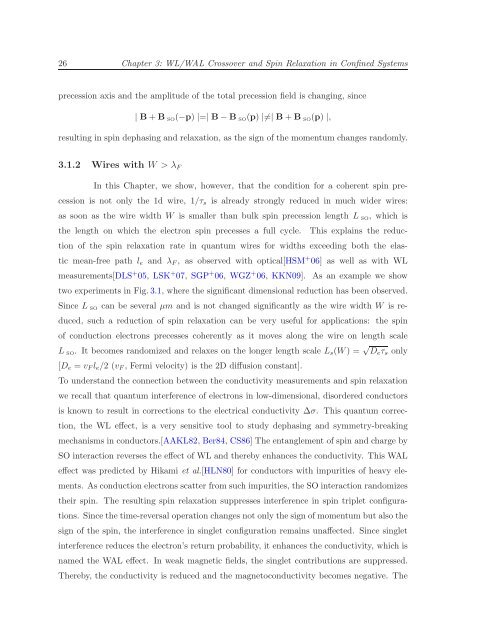Itinerant Spin Dynamics in Structures of ... - Jacobs University
Itinerant Spin Dynamics in Structures of ... - Jacobs University
Itinerant Spin Dynamics in Structures of ... - Jacobs University
You also want an ePaper? Increase the reach of your titles
YUMPU automatically turns print PDFs into web optimized ePapers that Google loves.
26 Chapter 3: WL/WAL Crossover and <strong>Sp<strong>in</strong></strong> Relaxation <strong>in</strong> Conf<strong>in</strong>ed Systems<br />
precession axis and the amplitude <strong>of</strong> the total precession field is chang<strong>in</strong>g, s<strong>in</strong>ce<br />
| B+B SO (−p) |=| B−B SO (p) |≠| B+B SO (p) |,<br />
result<strong>in</strong>g <strong>in</strong> sp<strong>in</strong> dephas<strong>in</strong>g and relaxation, as the sign <strong>of</strong> the momentum changes randomly.<br />
3.1.2 Wires with W > λ F<br />
In this Chapter, we show, however, that the condition for a coherent sp<strong>in</strong> precession<br />
is not only the 1d wire, 1/τ s is already strongly reduced <strong>in</strong> much wider wires:<br />
as soon as the wire width W is smaller than bulk sp<strong>in</strong> precession length L SO , which is<br />
the length on which the electron sp<strong>in</strong> precesses a full cycle. This expla<strong>in</strong>s the reduction<br />
<strong>of</strong> the sp<strong>in</strong> relaxation rate <strong>in</strong> quantum wires for widths exceed<strong>in</strong>g both the elastic<br />
mean-free path l e and λ F , as observed with optical[HSM + 06] as well as with WL<br />
measurements[DLS + 05, LSK + 07, SGP + 06, WGZ + 06, KKN09]. As an example we show<br />
two experiments <strong>in</strong> Fig.3.1, where the significant dimensional reduction has been observed.<br />
S<strong>in</strong>ce L SO can be several µm and is not changed significantly as the wire width W is reduced,<br />
such a reduction <strong>of</strong> sp<strong>in</strong> relaxation can be very useful for applications: the sp<strong>in</strong><br />
<strong>of</strong> conduction electrons precesses coherently as it moves along the wire on length scale<br />
L SO . It becomes randomized and relaxes on the longer length scale L s (W) = √ D e τ s only<br />
[D e = v F l e /2 (v F , Fermi velocity) is the 2D diffusion constant].<br />
To understand the connection between the conductivity measurements and sp<strong>in</strong> relaxation<br />
we recall that quantum <strong>in</strong>terference <strong>of</strong> electrons <strong>in</strong> low-dimensional, disordered conductors<br />
is known to result <strong>in</strong> corrections to the electrical conductivity ∆σ. This quantum correction,<br />
the WL effect, is a very sensitive tool to study dephas<strong>in</strong>g and symmetry-break<strong>in</strong>g<br />
mechanisms <strong>in</strong> conductors.[AAKL82, Ber84, CS86] The entanglement <strong>of</strong> sp<strong>in</strong> and charge by<br />
SO <strong>in</strong>teraction reverses the effect <strong>of</strong> WL and thereby enhances the conductivity. This WAL<br />
effect was predicted by Hikami et al.[HLN80] for conductors with impurities <strong>of</strong> heavy elements.<br />
As conduction electrons scatter from such impurities, the SO <strong>in</strong>teraction randomizes<br />
their sp<strong>in</strong>. The result<strong>in</strong>g sp<strong>in</strong> relaxation suppresses <strong>in</strong>terference <strong>in</strong> sp<strong>in</strong> triplet configurations.<br />
S<strong>in</strong>cethetime-reversal operation changes not only thesign <strong>of</strong> momentum but also the<br />
sign <strong>of</strong> the sp<strong>in</strong>, the <strong>in</strong>terference <strong>in</strong> s<strong>in</strong>glet configuration rema<strong>in</strong>s unaffected. S<strong>in</strong>ce s<strong>in</strong>glet<br />
<strong>in</strong>terference reduces the electron’s return probability, it enhances the conductivity, which is<br />
named the WAL effect. In weak magnetic fields, the s<strong>in</strong>glet contributions are suppressed.<br />
Thereby, the conductivity is reduced and the magnetoconductivity becomes negative. The
















